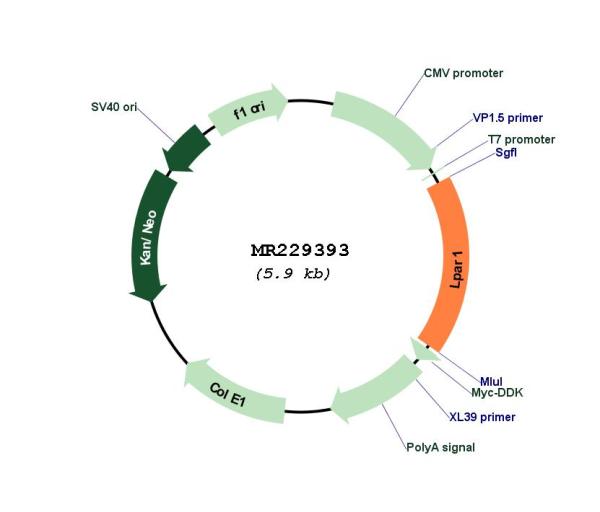Lpar1 (NM_001290486) Mouse Tagged ORF Clone
CAT#: MR229393
- TrueORF®
Lpar1 (myc-DDK-tagged) - Mouse lysophosphatidic acid receptor 1 (Lpar1), transcript variant 3
"NM_001290486" in other vectors (1)
Interest in protein/lysate? Submit request here!
USD 198.00
Specifications
| Product Data | |
| Type | Mouse Tagged ORF Clone |
| Tag | Myc-DDK |
| Symbol | Lpar1 |
| Synonyms | AI326300; Edg2; Gpcr26; Kdt2; lpA1; vzg-1 |
| Vector | pCMV6-Entry |
| E. coli Selection | Kanamycin (25 ug/mL) |
| Mammalian Cell Selection | Neomycin |
| Sequence Data |
>MR229393 representing NM_001290486
Red=Cloning site Blue=ORF Green=Tags(s) TTTTGTAATACGACTCACTATAGGGCGGCCGGGAATTCGTCGACTGGATCCGGTACCGAGGAGATCTGCC GCCGCGATCGCC ATGAACGAACAACAGTGCTTCTACAATGAGTCTATCGCCTTCTTTTATAACCGGAGTGGGAAATATCTAG CCACAGAATGGAACACAGTGAGCAAGCTGGTGATGGGACTGGGCATCACTGTTTGCGTGTTCATCATGTT GGCCAATCTCCTGGTCATGGTGGCAATCTACGTCAACCGCCGCTTCCATTTCCCTATTTATTACTTGATG GCCAACCTGGCTGCTGCAGACTTCTTCGCTGGATTGGCCTACTTCTACCTGATGTTCAATACAGGACCTA ATACCCGGAGACTGACTGTTAGCACGTGGCTCCTCCGGCAGGGCCTCATTGACACCAGCCTGACAGCTTC TGTGGCCAACCTGCTGGCTATTGCTATCGAGAGGCACATCACGGTTTTCCGCATGCAGCTCCATACACGA ATGAGCAACCGGCGCGTGGTGGTGGTGATTGTAGTCATCTGGACTATGGCCATTGTGATGGGTGCTATAC CCAGTGTGGGCTGGAACTGCATCTGTGATATCGATCACTGTTCCAACATGGCACCCCTCTACAGTGACTC CTACTTAGTCTTCTGGGCCATTTTCAACCTGGTGACCTTTGTGGTCATGGTGGTTCTCTACGCTCACATC TTTGGCTATGTTCGCCAGAGGACTATGAGGATGTCTCGGCATAGTTCTGGACCCAGGAGGAATCGGGACA CCATGATGAGCCTTCTGAAGACTGTGGTCATTGTGCTTGGTGCCTTTATTGTCTGCTGGACTCCGGGATT GGTCTTGTTATTGCTGGATGTGTGCTGCCCGCAGTGCGATGTCCTGGCCTATGAGAAGTTCTTCCTCCTC CTGGCCGAGTTCAACTCTGCTATGAACCCCATCATCTACTCCTACCGCGACAAAGAGATGAGCGCCACCT TCAGGCAGATCCTGTGTTGCCAGCGCAACGAGAACCCTAATGGCCCCACGGAAGGCTCTGACCGCTCTGC CTCCTCCCTCAACCACACCATTCTGGCTGGAGTTCACAGCAACGACCACTCTGTGGTT ACGCGTACGCGGCCGCTCGAGCAGAAACTCATCTCAGAAGAGGATCTGGCAGCAAATGATATCCTGGATT ACAAGGATGACGACGATAAGGTTTAA >MR229393 representing NM_001290486
Red=Cloning site Green=Tags(s) MNEQQCFYNESIAFFYNRSGKYLATEWNTVSKLVMGLGITVCVFIMLANLLVMVAIYVNRRFHFPIYYLM ANLAAADFFAGLAYFYLMFNTGPNTRRLTVSTWLLRQGLIDTSLTASVANLLAIAIERHITVFRMQLHTR MSNRRVVVVIVVIWTMAIVMGAIPSVGWNCICDIDHCSNMAPLYSDSYLVFWAIFNLVTFVVMVVLYAHI FGYVRQRTMRMSRHSSGPRRNRDTMMSLLKTVVIVLGAFIVCWTPGLVLLLLDVCCPQCDVLAYEKFFLL LAEFNSAMNPIIYSYRDKEMSATFRQILCCQRNENPNGPTEGSDRSASSLNHTILAGVHSNDHSVV TRTRPLEQKLISEEDLAANDILDYKDDDDKV |
| Restriction Sites |
SgfI-MluI
Cloning Scheme for this gene
Plasmid Map

|
| ACCN | NM_001290486 |
| ORF Size | 1038 bp |
| OTI Disclaimer | The molecular sequence of this clone aligns with the gene accession number as a point of reference only. However, individual transcript sequences of the same gene can differ through naturally occurring variations (e.g. polymorphisms), each with its own valid existence. This clone is substantially in agreement with the reference, but a complete review of all prevailing variants is recommended prior to use. More info |
| OTI Annotation | This clone was engineered to express the complete ORF with an expression tag. Expression varies depending on the nature of the gene. |
| Product Components | The ORF clone is ion-exchange column purified and shipped in a 2D barcoded Matrix tube containing 10ug of transfection-ready, dried plasmid DNA (reconstitute with 100 ul of water). |
| Reconstitution | 1. Centrifuge at 5,000xg for 5min. 2. Carefully open the tube and add 100ul of sterile water to dissolve the DNA. 3. Close the tube and incubate for 10 minutes at room temperature. 4. Briefly vortex the tube and then do a quick spin (less than 5000xg) to concentrate the liquid at the bottom. 5. Store the suspended plasmid at -20°C. The DNA is stable for at least one year from date of shipping when stored at -20°C. |
| Reference Data | |
| RefSeq | NM_001290486.1, NP_001277415.1 |
| RefSeq Size | 3247 bp |
| RefSeq ORF | 1041 bp |
| Locus ID | 14745 |
| UniProt ID | P61793 |
| Cytogenetics | 4 32.2 cM |
| MW | 39.8 kDa |
| Gene Summary | Receptor for lysophosphatidic acid (LPA) (PubMed:11087877, PubMed:18066075). Plays a role in the reorganization of the actin cytoskeleton, cell migration, differentiation and proliferation, and thereby contributes to the responses to tissue damage and infectious agents. Activates downstream signaling cascades via the G(i)/G(o), G(12)/G(13), and G(q) families of heteromeric G proteins (PubMed:8922387, PubMed:9600933, PubMed:11040035, PubMed:18157949, PubMed:18066075, PubMed:23478264). Signaling inhibits adenylyl cyclase activity and decreases cellular cAMP levels (PubMed:11040035, PubMed:12215548). Signaling triggers an increase of cytoplasmic Ca(2+) levels (PubMed:12215548). Activates RALA; this leads to the activation of phospholipase C (PLC) and the formation of inositol 1,4,5-trisphosphate (PubMed:11040035, PubMed:12215548, PubMed:23478264). Signaling mediates activation of down-stream MAP kinases (PubMed:11040035). Contributes to the regulation of cell shape (PubMed:8922387, PubMed:9600933, PubMed:11040035, PubMed:11087877). Promotes Rho-dependent reorganization of the actin cytoskeleton in neuronal cells and neurite retraction (PubMed:9600933, PubMed:11040035, PubMed:12181339). Promotes the activation of Rho and the formation of actin stress fibers (PubMed:9600933, PubMed:12215548). Promotes formation of lamellipodia at the leading edge of migrating cells via activation of RAC1 (PubMed:23478264). Through its function as lysophosphatidic acid receptor, plays a role in chemotaxis and cell migration, including responses to injury and wounding (PubMed:11087877, PubMed:18066075, PubMed:23478264). Plays a role in triggering inflammation in response to bacterial lipopolysaccharide (LPS) via its interaction with CD14 (PubMed:21821728). Promotes cell proliferation in response to lysophosphatidic acid (PubMed:9600933, PubMed:11087877, PubMed:12215548, PubMed:18157949, PubMed:17692995, PubMed:23478264). Required for normal skeleton development (PubMed:21569876). May play a role in osteoblast differentiation (PubMed:21569876). Required for normal brain development (PubMed:17656621, PubMed:18708146). Required for normal proliferation, survival and maturation of newly formed neurons in the adult dentate gyrus (PubMed:18708146). Plays a role in pain perception and in the initiation of neuropathic pain (PubMed:15195086, PubMed:19689455).[UniProtKB/Swiss-Prot Function] |
Documents
| Product Manuals |
| FAQs |
| SDS |
Resources
Other Versions
| SKU | Description | Size | Price |
|---|---|---|---|
| MC227182 | Lpar1 (untagged) - Mouse lysophosphatidic acid receptor 1 (Lpar1), transcript variant 3 |
USD 503.00 |
{0} Product Review(s)
Be the first one to submit a review






























































































































































































































































 Germany
Germany
 Japan
Japan
 United Kingdom
United Kingdom
 China
China


